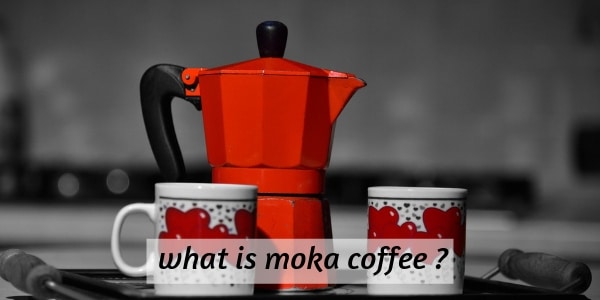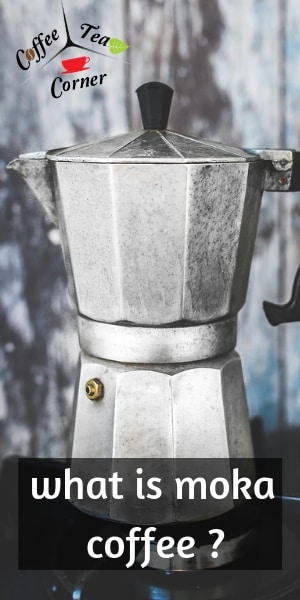When looking for a great brewing method, you'll find a plethora of options. One of them is the Moka pot, sometimes called a percolator. It's an Italian design, and it's been in use for nearly a century.
And it still has fans, even today. But what is Moka, anyway ? What is the Moka pot, and what does the Moka coffee taste like ?
Let me explain.

Table of Contents
So what is Moka coffee ?
Moka coffee is the drink made in a Moka pot. A Moka pot is a fairly large vessel, looking much like a pitcher. It's made out of metal, and it makes a sort of mock-espresso type coffee.
Moka coffee is a very strong, full bodied kind of drink. It is not a delicate brewing method, and the darker roasts seem to get the best results out of this kind of method. (Check this article for the best brewing methods)
You will need to watch over the Moka pot, and pull it off the heat when the coffee is done, lest it spills over.
The Moka pot is comprised of:
- a lower chamber in which water is heated to boiling point
- a filter containing coffee grounds, through which the water will pass
- an upper chamber, empty, where the actual coffee will end up
- a lid on top of the upper part
There are quite a few reasons people are in love with this charming coffee making method, so let's see why that is.
1. Medium-dark and dark roasts brew well in a Moka pot
Many people prefer a darker roast. This is in part because darker roasts take milk and sugar very well, and also because a darker roast is closer to what most of us know coffee tastes like.
It might sound like a trifle, but it's actually a key factor in why Moka is so popular. It was much more popular back in the day, and it's seeing a sort of resurgence these past decade.
So back to medium-dark and dark roasts. These roasts will bring forward that nutty, earthy, sometimes even chocolate-like flavor of coffee. It's going to be more bitter than light roasted coffee, and it may taste like it packs more of a punch.
In truth, the strength, as in the caffeine content, is the same in dark roast as it is in a light roast. But we tend to perceive dark coffee as stronger coffee.
Some brewing methods are better suited for lighter roasts, like the French press for example. Or the cold brewing method. With those you'll get the floral and fruity notes more clearly in your light coffee.
But with a Moka pot those notes are very much lost. This is both because of the temperature of the water as it comes through, and the amount of time it stays in contact with the coffee grounds.
Lightly roasted coffee needs a lower temperature water, and a Moka pot can only offer near-boiling water. It's the only way it works. This kind of water would scald the lighter roasts, and give you a very poor cup of coffee.
Add to that the fact that lighter roasts need a slightly longer steeping time, and you'll understand why a Moka pot is not for them.
Darker roasts shine in such a brewing method, though. They release their flavor faster, and brew quicker. This means you will lose some kinds of flavors that you only get in light roasts.
But then you get the flavors only found in dark roasts, so it's a bit of a trade-off.
So given how much people love darker roasts, me included, a Moka pot will be a great tool in getting a strong, thick cup of coffee.
Of course, you can always pimp your cup of coffee as much as you like with such a roast. Adding milk or cream will not affect the taste to the point where you can't taste the coffee.
2. Learning how to use a Moka pot is easy enough
Another reason a Moka pot is so convenient is the fact that learning how to use one is pretty easy. It takes a bit more skill than a French press, there you have to patient rather than skilled.
But in just a few brewing episodes, you'll be able to figure out just when to take the pot off the heat.
Some Moka pots come as electric pots, some are standard, stove-top versions. Both need you to stop the heat, though.
Let's break down how this thing works, so you see how easy it is. So in the lowest chamber you add the water. Most people use cold water, and that means the brewing time will be longer.
The water must be hot, so you can add water that's already hot and you'll considerably reduce the waiting time.
Once the water in the lower chamber heats up, pressure from the heat will push it upwards. It will go through the coffee grinds, and steep them as it goes.
Slowly, it will start to make its way up the spigot, which is connected to the upper chamber. There it will start overflowing, like a mini coffee fountain.
Once you're done brewing it though, you risk the Moka pot heating up the coffee liquid itself. This can result in your coffee overflowing and spilling onto your stove.
This happens only when you leave the room for too long and forget you're making coffee. This kind of pot is not as volatile ad a Turkish ibiric.
Still, you will need to take it off the stove when it starts making less of a gurgling sound, which is a sign there is no more water left to pass through the coffee grounds.
It might sound complicated to time, but this is the kind of thing that's easier to do than explain. I'm sure you'll make a great cup of coffee with this pot.
(If you like this article so far, you can pin it to your Pinterest board by clicking the image below. The article continues after the image.)
3. A Moka pot will produce a strong, espresso-like coffee
Speaking of great cup of coffee, this is debatable. While the Moka pot produces coffee in large amounts (depending on the lower chamber size), it's not always the best quality coffee.
This is something that coffee connoiseurs have noticed, but it's something I've never heard from regular people who just need a cup in the morning.
If you're looking for delicate notes and a coffee that will taste great black, the Moka is not for you.
But if you're looking for a simple, straight-forward cup of coffee then the Moka is right up your alley. It's strong, it's a little on the thicker side, and it often produces a crema like an espresso.
In a way, it really does resemble an espresso in terms of how it works.
So in depends on what kind of coffee you're after. If you're like most people and would like a strong cup of coffee, to add a lump of sugar and a shot of milk, then this kind of coffee is a very good choice.
4. The Moka pot can be taken on a camping trip
Another advantage of the Moka pot is that it's portable, unlike an espresso machine. I know, great comparison. But it's a valid one, once you look at how similar the Moka is to an espresso machine.
If you're out camping, then you've got to have a fire going somewhere. This means you can heat up the Moka pot, and prepare yourself a very nice cup of coffee, right in the middle of nowhere.
If you were to use an electric version, I'm not sure it would work out as well. But a standard version will do very well over a fire, or hot coal.
There is the matter of cleaning it, but this pot is easy to take apart, rinse, and then reuse as needed.
And there's something so very quaint about making your coffee over the fire, in the woods, with family and friends in the morning. Somehow the Moka pot seems to fit in very well, a bit rustic you might say.
5. Moka pots are easy to find, and fairly priced
This is yet another advantage, especially when you look at other brewing methods. Prices matter, and a Moka pot will not be as expensive as an espresso machine.
They're easy enough to find, in fact many of them are antique pieces. If you ask your grandma, she might remember using one of these in her early twenties.
When looking for a good Moka pot, make sure it's got all compartments very well separated, and it all fits together well.
No one wants leaky coffee pots, right ?
You could even find a Moka pot at the flea market, or at a yard sale. It's the kind of thing that you find and it seems to fall right into its place.
If you're looking for a recommendation, then this Moka pot will do the job very well. It's from a reputable Italian brand, and it's got the classic shape of the Moka pot down pat.
This particular one will brew you two cups of espresso, with a little bit left over. There are several other sizes, including ones that brew 12 cups of coffee.
It depends on how much coffee you need, and if you're willing to start the pot again if you need more.
The material is polished aluminium, and it's got a patented safety valve as well.
You can check the listing on Amazon here, and read the reviews as well.
How the Moka pot works
So we've gone through the main reasons Moka pots are very much loved. But let's go over how they work, since I realised we didn't cover that fully.
It's an easy enough machine to understand, once you know how it's built.
The lower chamber of the Moka pot is empty, and you need to fill it with water. That water is meant to become very hot, boiling almost. This means that if you add cold water you're going to have to wait for the pot to become hot, so the water will produce steam and start steeping the coffee grinds.
If you add already hot water, that's a much faster approach. Be warned though that water too hot will make your Moka pot nearly impossible to put together.
You won't be able to hold onto the parts well enough to screw them tightly. This can result in coffee leaking everywhere, or even the water not getting to the coffee grinds and spilling over instead.
The middle part is where the coffee grounds are stored. The upper part of this chamber is also a filter, through which the coffee liquid will escape and go up the spigot into the upper chamber.
It's important that you do not overpack the coffee grinds in the filter. The water needs to be able to pass through freely, and not be hindered by the grinds.
This part screws onto the lower part, and you'll notice it too has a spigot, leading down into the water. Once the water begins to heat up, steam and hot water will rise up into the coffee filter and start to steep the coffee.
Once the filter chamber is full, the pressure of the heated water in the lower chamber will start to push out the brewed coffee through the upper spigot.
The upper chamber is where the brewed coffee will collect. It will be a thicker coffee, since some essential oils and very very small coffee particles will be present. Not nearly as much as in other methods, but there will be a bit.
Coffee will keep coming up through the upper spigot until there is no more coffee left to come up. This means that the water has all evaporated into the coffee filter and there is no point in leaving the pot on the heat.
You can also check the status of the coffee by gently lifting the top lid with a spoon, careful to not get caught by steam. If there is coffee still coming out, then it's not done.
Once it is done though, take it off the heat.
What size coffee grind to use for a Moka pot
While the whole process of making Moka coffee is reminiscent of espresso, it does not mean the coffee should be ground the same way.
In an espresso machine, the coffee needs to be ground very very small, so the water has some resistance. The water comes very hot, and with large pressure, so a smaller grind will trap the water and act as a sort of temporary barrier.
With the Moka pot however, this is not necessary. The water needs to have more room to pass through. The pressure is much lower than in an espresso machine, which is part of the reason crema doesn't form as much with a Moka pot.
But a medium sized ground coffee will offer less resistance and be much better suited for the Moka pot. Again, remember to not overpack the coffee filter. It can only take so much once the coffee blooms.
Final thoughts
If you decide to use the Moka pot, you'll find yourself with a very charming and old-school way of making coffee. It produces large amounts of coffee, and it's always going to be a strong coffee with a full body.
It needs a little watching over, yes, but it's much like preparing tea. It's a ritual all by itself, and those few minutes spent waiting for the Moka pot to be done are very precious. They allow you to be calm and focused on the coffee pot, and nothing else.
If you want to know more about coffee or tea, feel free to check the related articles below. Who knows what else you might find ?






